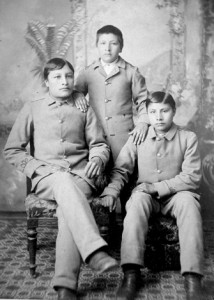A host of cruel practices were committed in the name of “civilizing” Indians. Though many children endured a hardscrabble life growing up on reservations, many others went to government boarding schools. Sometimes children were forcibly taken from their parents and put on trains without any preparation for leaving.
When they reached their schools, children were both brainwashed and miserably treated, because boarding schools had a mandate to cut the ties students felt to their homes and families. They were told that their race was inferior to the white race, that their practices were savage, and that even their religion was worthless.
Children were often not allowed to go home to visit their families. The schools were purposely far away from reservations so that it would be a great hardship for families to visit their children. By the time some of the students came home, they had forgotten how to speak their own language.
Boys often wore uniforms and learned to march. Showing homesickness was forbidden. Letters were sometimes intercepted and destroyed or censored. Runaways were a problem, so many children were locked in their rooms at night, or their windows were nailed shut.
Children who conformed to the new way of living were called “good Indians.” Those who resisted, ran away, spoke their native language, or complained were called “bad Indians.”

The Same Three Boys Beginning Civilized Life at Carlisle, National Anthropological Archives, Smithsonian
_________________________________________________________


